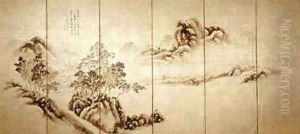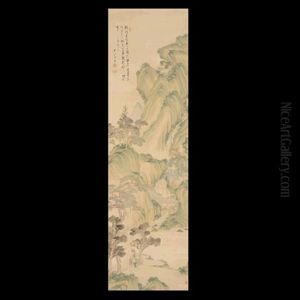Okada Hanko Paintings
Okada Hanko was a Japanese painter active during the late Edo period. He was born in 1782 in the domain of Tosa, which is now part of present-day Kochi Prefecture on the island of Shikoku, Japan. Hanko was known for his work in the Tosa school of painting, which was one of the two main schools of Japanese painting during the Edo period; the other being the Kano school. The Tosa school specialized in the yamato-e style, which focused on classical Japanese subjects and was characterized by its delicate and detailed narrative paintings that often depicted scenes from Japanese literature, poetry, and history.
Hanko's training and early life are not as well-documented as those of many of his contemporaries, but it is known that he became a master of the Tosa school and contributed to maintaining its traditional style during a time when Japan was facing significant internal and external pressures. His art was a reflection of the quintessential Japanese aesthetic and was deeply rooted in the cultural and artistic heritage of his time.
Throughout his career, Hanko produced works for the Imperial court and for high-ranking samurai families, which was a common practice for artists of the Tosa school. His paintings often featured themes from nature, such as birds, flowers, and landscapes, as well as courtly and literary themes, including scenes from The Tale of Genji and other classical works. Hanko's adherence to the Tosa school's traditional techniques and subjects was seen as a way of preserving a distinctly Japanese art form in the face of increasing Western influence during the late Edo period.
Okada Hanko died in 1846, having left behind a body of work that contributed to the longevity and appreciation of the Tosa school's artistic legacy. His works are valued for their historical and cultural significance, and they provide insight into the aesthetic values and social structures of his time. Although he may not be as widely known as some of his contemporaries, Hanko's contributions to Japanese art have been recognized by art historians and collectors, and his paintings can be found in museums and private collections in Japan and around the world.




